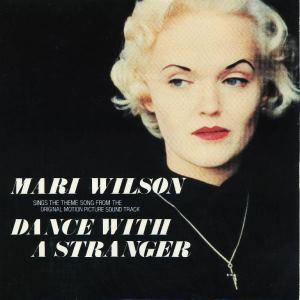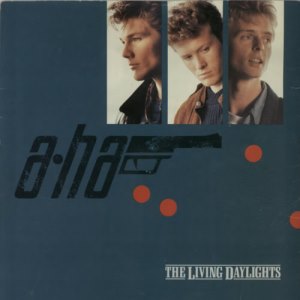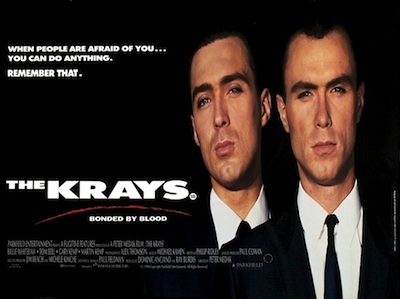
Sire W8717
The viewfinder icon next to her name on the sleeve is the only indication that this song is taken from the soundtrack to the film ‘At Close Range’, which starred
Madonna’s husband Sean Penn. The label copy for the American issue of the single contained details about the song’s inclusion in the film, and the promotional video clip for
Live To Tell shows Madonna in an empty studio singing the track, intercut with scenes from the movie. So it certainly wasn’t a secret that the song featured in the film; however, the information was of little use to British audiences who would have to wait until 12 September 1986 for the film’s release here, by which time the song was a distant memory. Over in the US, though, the film was released in the same week the single was issued in the UK:
Live To Tell appeared in the shops on Monday in UK, and ‘At Close Range’ was in cinemas on the Friday in the US.
As an actress, it’s generally agreed that Madonna’s first film was ‘Desperately Seeking Susan’; this, and her other movie credits for the 1980s, are discussed below, along with notes on her contributions to their soundtracks. But she had performed in two other film projects prior to this, and both were released in 1985. The first was soft-porn, low-budget Stephen Jon Lewicki movie ‘A Certain Sacrifice’, shot from 1979 to 1980 and unreleased until it was unearthed in 1985 due to Madonna’s growing fame. She lost a court battle on 2 August 1985 to have the film supressed, and was unable to persuade the director to sell her the rights, so it saw a video release on 1 October in the US that year. Her past was catching up with her, and the same year nude photos of her appeared in Playboy and Penthouse. None of this damaged her career in any way.
The second was ‘Vision Quest’, filmed in late ’83, in which she appears as a nightclub singer performing Gambler and Crazy For You: both tracks were featured on the Geffen soundtrack album and were issued as singles. (A copyright claim was filed for a third song, Warning Signs, but this was not used.) Although Madonna’s involvement was publicized when ‘Vision Quest’ was released to cinemas in America, the main promotional image used was a very unappealing sepia photograph of the film’s stars, Matthew Modine and Linda Fiorentino; the same picture was hand-tinted and used for the soundtrack album cover. In Australia, and later in the UK, the film was renamed ‘Crazy For You’ to strengthen the association with Madonna’s hit song, and she featured prominently in publicity material. Modine commented that it was a better title anyway, as ‘Vision Quest’ sounded like a sci-fi movie. A striking image of him in training (the character he plays is a boxer) that was used on the back cover of the soundtrack album was used on publicity posters for the re-titled release.
Madonna At The Movies
‘Desperately Seeking Susan’
Role: Susan Thomas (supporting actress)
US release date: 12 April 1985
UK release date: 6 September 1985
Soundtrack release: Madonna did record a title song for the movie, as did another artist, but neither was used in the finished film. Instead, Into The Groove (not specifically recorded for the film) was used as an unofficial theme and issued as a single, with a publicity photo of Madonna and the film’s star, Rosanna Arquette, on the sleeve. The promotional video clip for the song compiled footage from the film. The score for the film, composed by Thomas Newman, was released as an album along with Chas Jankel’s score for the film ‘Making Mr Right’.
Albeit a supporting cast member, Madonna’s part in the film was the title role. The job was perfect for her: ‘Susan’ was quick-thinking, fast-talking and street-wise, exactly the media image of Madonna herself. (In fact, if there was a criticism of her performance it was that she was effectively playing herself.)
‘Shanghai Surprise’
Role: Gloria Tatlock (co-star)
US release date: 29 August 1986
UK release date: 17 October 1986
Soundtrack release: none, but songs by George Harrison (whose film company, HandMade Films, produced it) were featured.
The Madonna backlash in the British media began in earnest with this movie. It seemed pointless to attack her music (you either liked her stuff or you didn’t, and given the chart positions it seemed most people liked it), so they went after her acting career instead. In February 1986 the film’s stars – husband and wife Sean Penn and Madonna – arrived in the UK for filming. Provoked by the press, who hoped some minor scuffles they orchestrated would develop into full-blown fights and lead to more negative press for Sean, they were nicknamed ‘the Poison Penns’ during their visit and the film was panned on release. It wasn’t just in the UK that the film was received badly; the film was nominated as Worst Picture at the Seventh Golden Raspberry Awards, Penn was nominated as Worst Actor, and Madonna won Worst Actress.
‘Who’s That Girl?’
Role: Nikki Finn (lead)
US release date: 7 August 1987
UK release date: 23 October 1987
Soundtrack release: album Who’s That Girl marketed as a Madonna album, but only four of the songs are hers. Three were issued as singles (the title track, Causing A Commotion, and The Look of Love) and she performed them all on her Who’s That Girl world tour. (The remaining cut was Can’t Stop.)
The working title for this comedy was ‘Slammer’. Madonna won her second Worst Actress award at the following year’s Golden Raspberry Awards.
‘Bloodhounds of Broadway’
Role: Hortense Hathaway (cameo)
US release date: 3 November 1989
UK release date: no theatrical release
Soundtrack release: none. Madonna duets with Jennifer Grey during the film (I Surrender Dear) but this has never appeared on an audio-only format.
The film opened in the US to a very limited release and was straight-to-video in the UK, available at rental stores from 7 December 1990. Once again, Madonna had a nomination at the Razzies, this time for Worst Supporting Actress.
NEW SINGLES on sale from Apr. 14
1986
The ALARM Knife Edge (IRS IRM112)
DEPECHE MODE A Question Of Lust (Mute 7BONG11)
MADONNA Live To Tell (Sire W8717)
SADE (Sade Adu) Never As Good As The First Time (Epic A7061)

















